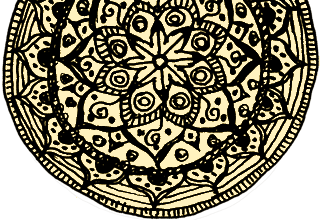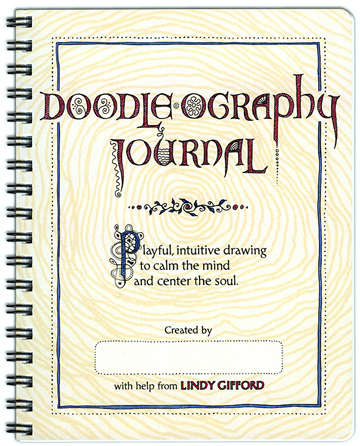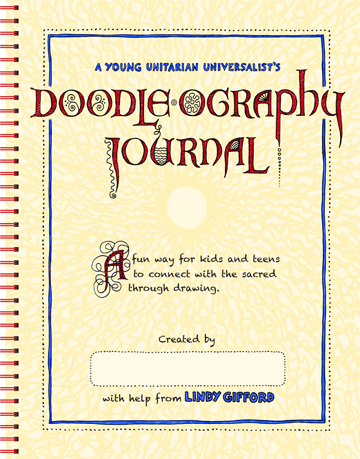There’s more to Doodling than you might think.
Do you doodle, or did you when you were younger? Did people tell you that meant that you were not paying attention? It turns out the exact opposite is true. Research shows that individuals who doodled while listening to a monotonous telephone recording retained up to 29% more information than those who did not.* And retaining more information is only one of the many benefits of doodling. The result has been an explosion of interest in doodling, and books and programs based on doodling.
How is Doodle-ography different from other doodling books?
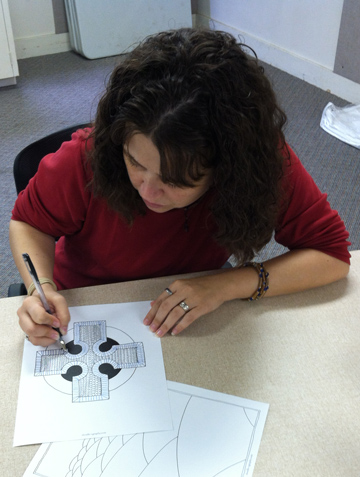
The images and quotes in the Doodle-ography Journals are both interfaith and secular—there’s something to inspire everyone.
The Doodle-ography Journal stands out from these in several ways. First, it approaches doodling as a spiritual practice and a proven tool for increased self-awareness. Second, it is a journal and non-directive guide, rather than a how-to book. Lastly, it is beautifully designed and produced on smooth, thick paper with a strong wire binding—like a quality sketchbook. The journal provides a safe, inspiring container for your new, growing practice.
What that means is, this is a practice that you create for yourself, you are not given formulas to imitate someone else's practice. It also means that it's a practice that you can easily stick with. The journal is designed so that you can use it anywhere, with out a desk or table. Take it with you on the bus or train, in waiting rooms, to meetings. If anyone questions you, tell them it uses a part of the brain that helps you retain what you hear—unlike those who are answering emails on their cellphones!
Make your own coloring book!
Why color someone else's art? With the Doodle-ography Journal it's easy and fun to create your very own coloring book. Just doodle in black ink and then color in your doodles with markers or colored pencils. Both the doodling and the coloring are relaxing—and creative. Best of all, the end result will be your original creation, from start to finish!
Who can benefit from Doodle-ography?
Anyone. The DOODLE-OGRAPHY JOURNAL (for everyone) is designed primarily for adults. Whether they are an artist, or tell everyone they can’t draw a straight line, people discover the Doodle-ography Journal as refreshing and surprising. Those who doubt their ability find a non-threatening container for experimentation and are always amazed by what they create. Artists find it freeing to let go of expectations and stop trying so hard, and are also often surprised by the results.
There is also a journal specifically for Unitarian Universalist children and youth: A YOUNG UNITARIAN UNIVERSALIST'S JOURNAL. Most kids love to doodle, and really appreciate being given permission to do so. They take to the journal easily and often can’t wait to get back to it. And it really helps them calm and center themselves. Children who struggle with anxiety or attention issues enjoy especially good results.
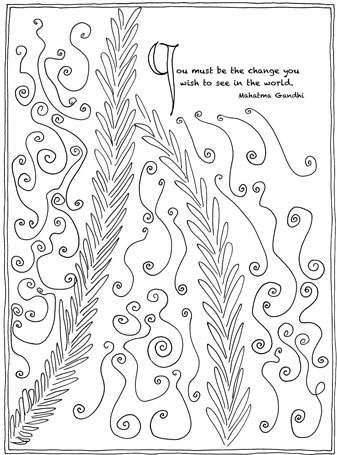
Doodles by Phoebe Cole.
What’s the best way to get started?
Truly, anyone can do this. It is really only a question of being open to the process and there is a page of tips for getting started in every journal. We also offer workshops, which can be very helpful especially for getting a group started. The insights and self-awareness that arise from using the journal are often even more pronounced in a group setting. We recently witnessed in a workshop with women veterans just how healing this group process can be.
How do you do Doodle-ography?
Try to let go of expectations and embrace the mystery. Experiment without any plan in mind and follow where your heart and hand lead. Let your intuition, not your thinking mind, be your guide. Start by creating patterns and abstract designs rather than recognizable images. If you hear from your inner critic, just let it go and keep on doodling. As you open yourself to the process you will eventually find a place of sacred quiet, as the incessant chattering of the mind is stilled.
There are no mistakes in this process, so be brave. To start with, we suggest you use a good quality black pen that cannot be erased. (Gel pens work well, and art pens are even better.) Start doodling on any page that looks inviting and move in any order. Many people like to start with the pages that contain simple graphics. Try filling each section with a different pattern. Other pages have a starting point from which organic, free-form designs can unfold. Still others have written meditations. Hear the words as you read them and incorporate them into your doodles. Lastly some pages are completely blank, for doodling without constraints.
As you become comfortable with the process, you may want to add colored pencil or markers to the black outlines, or experiment with drawing the lines themselves in color. (The paper is heavy enough that even felt tip pens will not bleed through.) Many people prefer to stick with black. You will find a style that works best for you.
You may end up adding words as well. To create a visual prayer, write someone’s name and let your doodled embellishments grow as you hold them in your heart. You might record your own or other’s words and make them into visual meditations as well. Bring your journal to meetings, lectures, and religious services. Carry your journal in your briefcase or purse and use it on the train, bus, plane, or in waiting rooms. Or keep it in one special place, just for quiet contemplation.
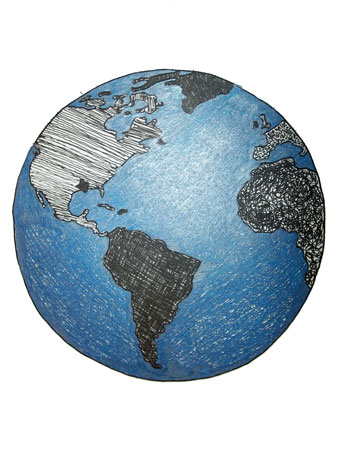
Doodles by Gigi Tharpe.
How is doodling a spiritual practice?
First of all, research shows that people who doodled while listening to a monotonous taped message retained up to 29% more information than those who did not.* Doodle-ography helps to center and quiet the mind, like other forms of meditation. Because it is a tactile meditation, like prayer beads and rosaries, Doodle-ography is accessible to everyone, even those who have not had success with other meditations.
Doodle-ography is also a form of process art. “Process art” is an artistic movement in which the creative journey or “process” is more important than the product. In recent years a growing number of people—not just “artists”—have been experiencing its transformative power through process art workshops and therapy. The Doodle-ography Journal is an easy and accessible way to draw on that power—every day.
Once, all art was “process art,” before the focus shifted to the finished piece. The oldest of art, cave painting, was ritual art created far from “public view” and often overlapped, obscuring the images. Ritual visual art survives in ceremonies such as Native American and Tibetan sand painting. The Doodle-ography Journal also shares roots with another religious art tradition, that of the illuminated manuscript and medieval Book of Hours. Like all these sacred art forms, Doodle-ography taps into something profound and universal.
* J.Andrade, “What does doodling do?” Applied Cognitive Psychology (2010) Volume 24, pp. 100-106.
What are Doodle-ography's origins?
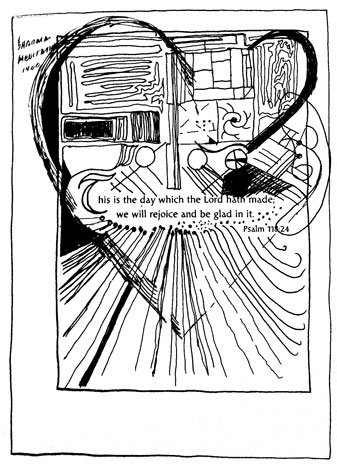
Doodles by Angie B. Blevins.
Lindy Gifford, the creator of Doodle-ography, has doodled her whole life and was always told not to by her teachers. In spite of that, she grew up to become an artist and graphic designer. She got to know artist and art educator, Brady Nickerson, through taking process art workshops with her. When Brady discovered the research on the benefits of doodling, she began collaborating with teachers at the local grade school to use doodling with the students as a calming and centering technique. The teachers could hardly believe the results, particularly with children who suffered from attention and anxiety issues. Meanwhile, Lindy began studying to become an interfaith chaplain and realized that she was already using doodling as a spiritual practice, and that others could as well.
Lindy created her first spiral bound doodling journal for the children at her Unitarian Universalist congregation, where she was serving as Director of Religious Education. Out of that grew the A YOUNG UNITARIAN UNIVERSALIST'S JOURNAL, which is now widely used in UU congregations throughout the United States, and soon after she published the DOODLE-OGRAPHY JOURNAL (for everyone). In 2018 she published new revised editions of both, and she is currently working on a new Doodle-ography book with new, enhanced content.
Doodle-ography is dedicated to helping get the benefits of doodling to as many people as possible—both adults and children. So if you think it’s as great as we do, please help spread the word! Start a group, or help bring it to the attention of a local organization, school, or church. We offer volume discounts for groups.
